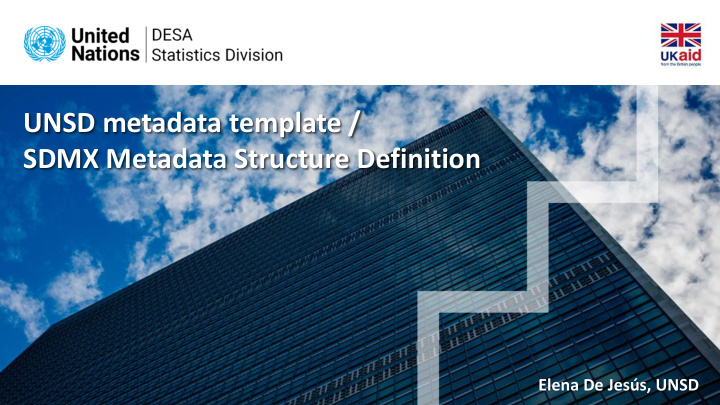



UNSD metadata template / SDMX Metadata Structure Definition Elena De Jesús, UNSD
Standardized metadata improves usability and comparability • Metadata (and data) that follow specific standardized patterns: • are easier for users to interpret and lend themselves to machine readability and electronic exchange • use a common template for organizing metadata • improve comparability of data, both at the global level (between countries), and within countries – to understand comparability in time series over time Statistics Division
SDMX (Statistical Data and Metadata eXchange) • International initiative that aims at standardising and modernising the mechanisms and processes for the exchange of statistical data and metadata • Sponsored by seven international organisations: BIS, ECB, Eurostat, the IMF, OECD, UNSD and the World Bank • Consists of: • technical standards • statistical guidelines • an IT architecture and tools • Reduces reporting burden • Enhances availability of statistical data and metadata for the users • Data reporting = data dissemination = data sharing (one dataset is reported only once and then shared widely using modern technologies) Statistics Division
Metadata in SDMX • Can be stored or exchanged separately from the data object it describes, but be linked to it • Can be indexed and searched • Reported according to a structure defined by the Metadata Structure Definition (MSD) Statistics Division
Overview of the SDG metadata template • Metadata template approved by the SDG SDMX Working Group of the Inter-agency and Expert Group on SDG Indicators (IAEG-SDGs) ➢ Metadata template for National Reporting (containing instructions specific to countries developed by UNSD) • Contains two main parts: • Metadata attachment • Metadata concepts Statistics Division
Attachment The metadata attachment refers to the way in which the metadata is associated with the datasets it describes. In SDMX for the SDGs, metadata is attached based on the following three parameters: • Reporting type (Global, Regional or National) • SDG Series • Reference Area (Countries and regions) In addition, Language is also specified (SDMX metadata is multilingual) Statistics Division
Attachment (Kyrgyzstan Example) Statistics Division
Concepts • In the Metadata Structure Definition (MSD), the concepts describe all relevant characteristics of the metadata • SDG metadata concepts (7) : • Indicator information • Data reporter • Definition, concepts and classifications • Data source type and data collection method • Other methodological considerations • Comparability/deviation from international standards • References and documentation Statistics Division
Concept: Indicator information (Kyrgyz Example) Statistics Division
Concept: Data reporter (Kyrgyz Example) Statistics Division
Concept: Definition, concepts and classifications (Kyrgyz Example) Statistics Division
Concept: Data source type and data collection method (Kyrgyz Example) Statistics Division
Concept: Other methodological considerations (Kyrgyz Example) - Part 1 Statistics Division
Concept: Other methodological considerations (Kyrgyz Example) - Part 2 Statistics Division
Concept: Data Availability and disaggregation (Kyrgyz Example) Statistics Division
Concept: Comparability/deviation from international standards (Kyrgyz Example) Statistics Division
Concept: References and documentation (Kyrgyz Example) Statistics Division
Recommendations for drafting and compiling metadata • Prepare metadata that is comprehensive but not overwhelming (mandatory fields vs. describing everything) • Use standard terminology and avoid duplication (document necessary variations from standards) ▪ Create descriptions that are easy to understand for different stakeholders ▪ Preserve historical metadata e.g. changes when methods of data production change ▪ Document workflows e.g. around ownership, approval, date of operation ▪ Create metadata in local languages where possible ▪ Include contact details - and ensure contact points are monitored Statistics Division
Thank you
Recommend
More recommend